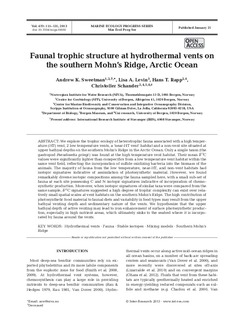| dc.contributor.author | Sweetman, Andrew Kvassnes | |
| dc.contributor.author | Levin, Lisa | |
| dc.contributor.author | Rapp, Hans Tore | |
| dc.contributor.author | Schander, Christoffer | |
| dc.date.accessioned | 2018-08-08T10:28:01Z | |
| dc.date.available | 2018-08-08T10:28:01Z | |
| dc.date.created | 2013-05-11T12:45:34Z | |
| dc.date.issued | 2013 | |
| dc.identifier.citation | Marine Ecology Progress Series. 2013, 473 115-131. | nb_NO |
| dc.identifier.issn | 0171-8630 | |
| dc.identifier.uri | http://hdl.handle.net/11250/2508023 | |
| dc.description.abstract | We explore the trophic ecology of heterotrophic fauna associated with a high temperature (HT) vent, 2 low temperature vents, a ‘near-HT vent’ habitat and a non-vent site situated at upper bathyal depths on the southern Mohn’s Ridge in the Arctic Ocean. Only a single taxon (the gastropod Pseudosetia griegi) was found at the high temperature vent habitat. Their mean δ13C values were significantly lighter than conspecifics from a low temperature vent habitat within the same vent field, reflecting the incorporation of sulfide oxidizing bacteria into the biomass of the animals. The majority of fauna from the low temperature, near-HT, and non-vent habitats had isotopic signatures indicative of assimilation of photosynthetic material. However, we found remarkably diverse isotopic compositions among the fauna sampled here, with a small sub-set of fauna at each site possessing C and N isotopic signatures indicative of incorporation of chemo - synthetic production. Moreover, when isotopic signatures of similar taxa were compared from the same sample, δ13C signatures suggested a high degree of trophic complexity can exist over relatively small spatial scales at vent habitats on the southern Mohn’s Ridge. The high contribution of photosynthetic food material to faunal diets and variability in food types may result from the upper bathyal venting depth and sedimentary nature of the vents. We hypothesize that the upper bathyal depth of active venting may lead to iron enhancement of surface photosynthetic production, especially in high nutrient areas, which ultimately sinks to the seabed where it is incorporated by fauna around the vents. | nb_NO |
| dc.language.iso | eng | nb_NO |
| dc.publisher | Inter Research | nb_NO |
| dc.relation.uri | http://www.int-res.com/articles/meps_oa/m473p115.pdf | |
| dc.title | Faunal trophic structure at hydrothermal vents on the southern Mohn's Ridge, Arctic Ocean | nb_NO |
| dc.title.alternative | Faunal trophic structure at hydrothermal vents on the southern Mohn's Ridge, Arctic Ocean | nb_NO |
| dc.type | Journal article | nb_NO |
| dc.type | Peer reviewed | nb_NO |
| dc.description.version | publishedVersion | nb_NO |
| dc.rights.holder | © Inter-Research 2013 | nb_NO |
| dc.subject.nsi | VDP::Marinbiologi: 497 | nb_NO |
| dc.subject.nsi | VDP::Marine biology: 497 | nb_NO |
| dc.source.pagenumber | 115-131 | nb_NO |
| dc.source.volume | 473 | nb_NO |
| dc.source.journal | Marine Ecology Progress Series | nb_NO |
| dc.identifier.doi | 10.3354/meps10050 | |
| dc.identifier.cristin | 1027992 | |
| dc.relation.project | Norges forskningsråd: 179560 | nb_NO |
| cristin.unitcode | 7464,20,14,0 | |
| cristin.unitname | Marin biogeokjemi og oseanografi | |
| cristin.ispublished | true | |
| cristin.fulltext | original | |
| cristin.qualitycode | 2 | |
